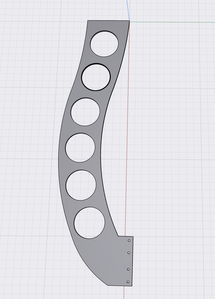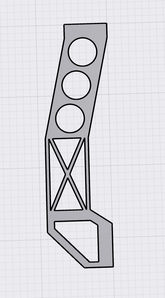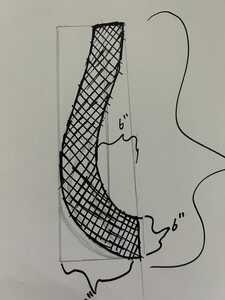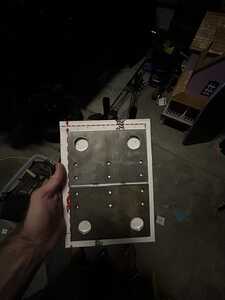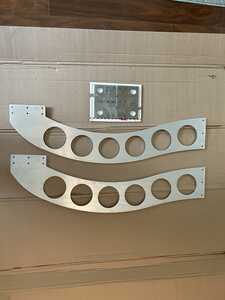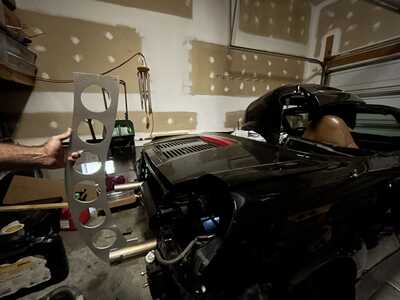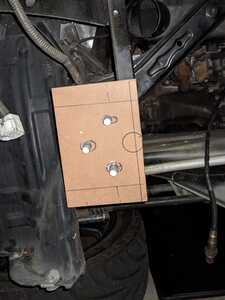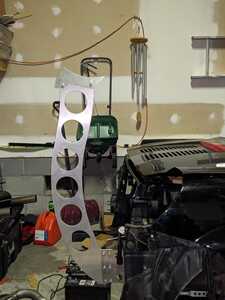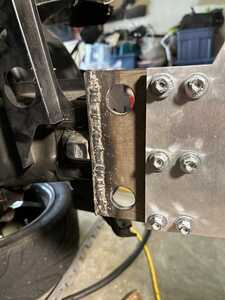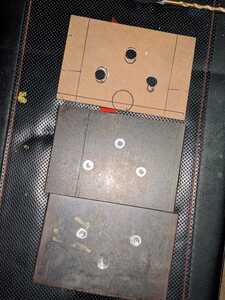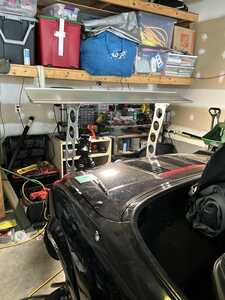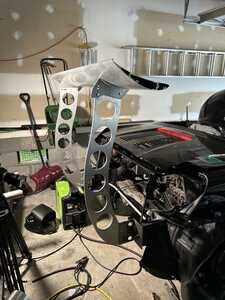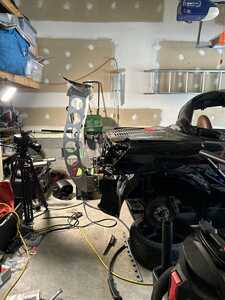Looking good Patrick. I think the C-one and the lip kit completes the car. It makes it look longer like a supercar than a short roadster.
playing around with some cad.. any idea what i'm working on? lol I've never actually ever used CAD or any 3d creation software, so i'm super happy with how this turned out. measurements are 6" mounts on both the wing side and the body side and a total height from bottom to top of 36" so it's a big boy..
this is the first "design" i had while I was figuring out how to use the software.. So many possibilities now!
www.patricklipp.com
www.mytechliving.com
Looks like you're attaching to the rear tow hook locations. That's a pretty good idea if you can design it all to work and be modular. That will allow you to not have to cut any of the rear bumper (Unless you want to cut the small inserts that pop out for the tow hook access instead of just leaving them off of the car).
Nice!
Get your Short Antennas, Decals, and all sorts of goodies at:
https://takubanmotorsports.com
Looks like you're attaching to the rear tow hook locations. That's a pretty good idea if you can design it all to work and be modular. That will allow you to not have to cut any of the rear bumper (Unless you want to cut the small inserts that pop out for the tow hook access instead of just leaving them off of the car).
Nice!
My current design doesn’t account for the row hook, but I am planning on making it accessible..
www.patricklipp.com
www.mytechliving.com
I also now have a source for sheet metal and 1/4” steel plate along side using a site that will do custom cnc work. I’m also going to get some aluminum cut to size and start working on a design for an under tray along with from splitter and rear diffuser. Now that I taught myself 3d design, I’ve got so many ideas. Lol
www.patricklipp.com
www.mytechliving.com
Oh yeah, I’m also about to pick up a pipe bender for a one off, custom header. I’m also contemplating a 2zz swap and converting to e85 for a few extra HP.. having a gas station with everything from e85 and e90, to 93, and then ethanol free 89(great for my boat!) within walking distance has opened some doors. Lol
im probably delusional, but the enjoyment of working with metal has gotten to my head a bit.. I’ve been reading everything I can on maximizing NA power in terms of intake and exhaust, so with a 2zz and a few breathing mods, I’d imagine I can get some decent numbers … that and aerodynamics if you couldn’t tell. Lol
With that said, im not delusional of the realistic numbers, more of curious as to what something less conventional that what everyone else is doing could yield. I’ve been heavily considering various Frankenstein setups such as modified 2zz intake manifold on a 1zz, 1.75” exhaust runners instead of 1.5”, unequal length shorty headers with a substantially shortened exhaust as a whole, different sized throttle bodies, multi runner intakes, blahblahblah..
essentially all of the ridiculous questions people have asked on SC over the years, I may be crazy enough to try them. 🤦🏼🤷♂️
www.patricklipp.com
www.mytechliving.com
@pattielipp e90 you say... Interesting. Over the past few months I have been blending E85 with pump 93 in the subie. Nothing serious because I'm unwilling to make the tune depend on my fuel blend... Ethanol heavy fuels are not very popular here for some reason and there is significant variance in what is coming out of the pump at most locations. I only have one reliable source for 80%+ ethanol (thankfully also the cheapest local source).... Rambling aside.... I've been using 9:1 93 E10 and E85, which yields a hypothetical maximum ethanol percentage of E17. With no modifications to the tune I have noted better throttle response, smoother and more consistent power output, and a significant decrease in the negative effects of the (ridiculous) ambient temperatures the car suffers this half of the year. There has also been no negative effects on fuel economy, unless it's an all city tank.... that fault is entirely with my right foot and the previously mentioned throttle response improvement. The extra effort of blending my own fuel also drops my average price per gallon by ~10¢ (whoopee).
A couple weeks ago I decided I was gonna try the same blend in the toy... And although the effects aren't as profound with the NA 2zz, it still feels better than before. I've never felt the power delivery this consistent or strong with ambient temps over 100F. Similar to what the car feels like with ambient temps around 70F.
A couple weeks ago I decided I was gonna try the same blend in the toy... And although the effects aren't as profound with the NA 2zz, it still feels better than before. I've never felt the power delivery this consistent or strong with ambient temps over 100F. Similar to what the car feels like with ambient temps around 70F.
This is starting to sound like a new thread. Ethanol is a very interesting fuel, and the off-side marketing and distribution has done years of damage to a strong energy carrier with good "lower carbon" and renewable foundation with performance benefits. I worked for GM on flex-fuel for a time and also with folks at the national labs. As @Pattielipp noted one of the issues is inconsistent blending. E85 ASTM standard can be as low as E65 (? maybe even lower - my memory is going) having a flex fuel sensor helps with tune of course - but adds complexity. It is also a really cool fuel for dual fuel applications (ethanol additional to other fuels) in addition to the octane bump and charge cooling.
@rdawg @marseock7 I think E85 could add some extra power while also increasing the overall safety. reduced intake temps, better knock protection, etc. I’ll probably do the conversion on the 1zz and play with it until it blows, just need to figure out the fueling. I’ve got the pfc, so no issues there, and that extra bit of knock protection is good since there is none on the pfc.. then it’s a matter of fuel pump, fuel filter, and injectors. If my memory is correct, I’ll need roughly 30% more fuel with ethanol over standard pump gas. Similarly, I think stock 1zz injectors are pushing their max “safe” injector duty up around WOT and redline. If I’m planning on going 2zz swap here at some point, and the yellow injectors are 310cc, then basic math says 30% larger puts them around 400cc, do injectors around that 400cc mark at stock fuel pressure should suffice for future proofing.
www.patricklipp.com
www.mytechliving.com
@pattielipp I am by no means an expert on the topic - but I worked with them. Ethanol is a neat fuel or it sux depending on the situation. I think you mean Ethanol has some capability for 'charge cooling' not lowering Intake air temps. Due to its latent heat of vaporization, I don't recall all of the details, but as it evaporates it will drop temps going into the combustion chamber, or something like that. And there is the higher octane, slower flame front - I can't remember how that works for combustion swirl, etc. For engines designed & tuned to run on Ethanol, run more spark and can actually get better thermal efficiency, but engines designed tuned to run on both E85 suffers.
The other issue is that high ethanol blends are typically very good cleaning fuels and can be corrosive (If I remember right) The like to absorb water - but at limits can phase change and become a mess. It is also a conductive fuel. And though we had a really cool fuel tank that exploded in one guy's office (The truck was in Alaska - cold enough for right air/fuel ratio in the tank and just the right static discharge in the tank? we think (it was a prototype)... poof - not boom, the guy didn't even know it blew until the next time he filled and fuel ran on to the ground.
Anyway - its more than getting the right A/F ratio to make any power - you also have to change timing. I think your in SC? The biggest place we noticed improvements were at altitude above 6K ft, there was some benefit lower when we tuned just for E85 use, like .2 sec 0-60. But like I said - we were tuning flex fuel vehicles. Had to run equally well on both. Build it for E50-85, you might get a little more HP at low altitudes.
Old fuel lines probably won't be an issue in our cars, but I wouldn't use it in a pre- 1995 (or so) without changing them same goes for a lot of seals.
Pumps can be a messy topic. Again - we were trying to build for 150+K miles on what might be crap fuel. So we used a ruggedized pump with a carbon commutator to help with wear in the presence of fuel that has absorbed water - gets nasty. Same can go for the pump 'sock' which is typically located at the inlet to the pump. Poor E85 or stuff with water, etc can form a while goo that clogs things up...
The last thing is - as I mentioned - its a good cleaner, so it can clean the oil film (Often desired) off of engine parts - like cylinder walls, Valves, etc. Not something to likely worry about, but it was noted in Direct injection research.
Your back of the envelop calc for injector sizing seems good.
@rdawg A couple things to note. First, you're right, I'm not necessarily talking about intake air temps, but rather combustion chamber temps to prevent detonation. I live in SC and the day time temps have recently been in the 90-100 degree range. Mix that with a black car and I'm looking at intake temps well in excess of "Normal", so using a fuel that can reduce the initial atomized air/fuel temp in the combustion chamber helps.
On the side of tuning, I am running the apexi Pfc, so altering the ignition map wouldn't be an issue. I'm surprised by altitude playing such a role, but perhaps this is because of the increased oxygen content of ethanol vs conventional fuel? regardless, if that's the case, being at sea level, I'm already at a better "Starting point", not having to compensate for the decreased density of the air.
I guess, since you mentioned it, I could see the cleaning properties being good for cleaning out the oil control rings, and carbon deposits on the top of the pistons and potential deposits on the valves. I haven't driven the car enough to tell if it is burning oil, but perhaps ethanol could help out a bit if it's the oil control rings that are doing it. I know I have some increased crank case pressure, so I'd be interested to see what all happens over time.
Now, you mention the absorption of water and the nasty mess it can leave behind. I deal with that with my boat, one of the reasons I run ethanol free gas in it, so I'm aware of those potential issues. This car has the potential to sit for a while which is why I normally leave the fuel tank below 1/4 when it sits for a period longer than a few weeks. Then when I add new fuel, it all gets mixed and hopefully burned and nothing gets clogged. I've had good luck with this method thus far, and in the occasion it's a long stint, I'll add a fuel additive in to help clean/break stuff down, similar to a post winterization of other equipment.
www.patricklipp.com
www.mytechliving.com
@pattielipp When I worked in the Sport boat business - they went all Ape -$#!t on me when I spoke about building an E85 boat for a project. It's all about design and fuel management - but I digress.
You seem to be on top of it with your method to manage possible contamination... Not likely to have any issues. The high content fuel acting like a cleaner can also impact fuel lines and what's in the tank. this is a part of the reason boaters hate it. Old boats with old lines - and in the case of old sail boats sometime Fiberglass tanks - no I am not kidding. All this spells a world of hurt. Newer boats are ready for e10, and the phase change thing only happens at high water concentrations.
great stories from SHELL experts about how small contamination from Ethanol got into valve train of prototype racing engine and caused all sorts of issues. their next round of racing oil benefitted from that knowledge. Its amazing what bounces around a stressed engine.
Good luck. It's MAF mod for me next... something simple and cheap.
@rdawg All things being equal (like temp, pressure and air/fuel ratio) ; Ethanol content actually increased flame speed. We judge this by the property called Laminar Flame Speed or Laminar Burn Velocity, which is not the same as actual (turbulent) flame speed, but it is proportional. Here is a study: https://pubs.aip.org/aip/acp/article/2191/1/020063/1007453/Development-of-gasoline-ethanol-blends-laminar

